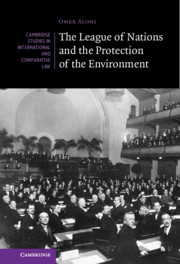Book contents
- The League of Nations and the Protection of the Environment
- Cambridge Studies in International and Comparative Law: 159
- The League of Nations and the Protection of the Environment
- Copyright page
- Contents
- Acknowledgments
- Introduction
- 1 Fighting Pollution Made by Humankind
- 2 The League of Nations and the Whaling Dilemma
- 3 Sanitation, Spreading Diseases, and Environmental Concerns: The League of Nations’ Campaign for Rural Hygiene
- 4 Raw Materials, the Timber Crisis, and Fears of Deforestation during the Interwar Period
- 5 Evaluating the Environmental Regime of the League of Nations: Comparative Discussion
- Conclusion
- Bibliography
- Index
- Cambridge Studies in International and Comparative Law
5 - Evaluating the Environmental Regime of the League of Nations: Comparative Discussion
Published online by Cambridge University Press: 30 April 2021
- The League of Nations and the Protection of the Environment
- Cambridge Studies in International and Comparative Law: 159
- The League of Nations and the Protection of the Environment
- Copyright page
- Contents
- Acknowledgments
- Introduction
- 1 Fighting Pollution Made by Humankind
- 2 The League of Nations and the Whaling Dilemma
- 3 Sanitation, Spreading Diseases, and Environmental Concerns: The League of Nations’ Campaign for Rural Hygiene
- 4 Raw Materials, the Timber Crisis, and Fears of Deforestation during the Interwar Period
- 5 Evaluating the Environmental Regime of the League of Nations: Comparative Discussion
- Conclusion
- Bibliography
- Index
- Cambridge Studies in International and Comparative Law
Summary
The chapter provides a broader comparative view of the League’s environmental concerns. The main aim of the discussion in this chapter it to weave these different initiatives (which are described separately in each chapter) into a coherent and broad regime, ones that has a common ground, continuity, and certain dynamics. As each chapter explains the role played by central theories, ideas, conflicting interests, environmental challenges, and scientific or professional concerns, this chapter puts them together and explain some of the differences and common patterns. Moreover, this analysis also revises the League’s different endeavors from contemporary environmental perspectives, and assesses their relevance to current dilemmas where nature protection conflicts with human needs.
Each of the chapters explores a different dimension of the League’s environmental policy. They focus on the environmental impacts of pollution of the sea by oil, the growing whaling industry and endangered whales, rural hygiene and sanitation problems in the periphery, and timber production and fears of spreading deforestation. There may well be other interwar concerns that also involved environmental perspectives. However, I present a sweeping legal-historical overview of several of the central environmental challenges that the interwar world faced, in order to understand the notions behind the League’s leadership and to explain its shortcomings and achievements.
Keywords
- Type
- Chapter
- Information
- The League of Nations and the Protection of the Environment , pp. 291 - 337Publisher: Cambridge University PressPrint publication year: 2021

